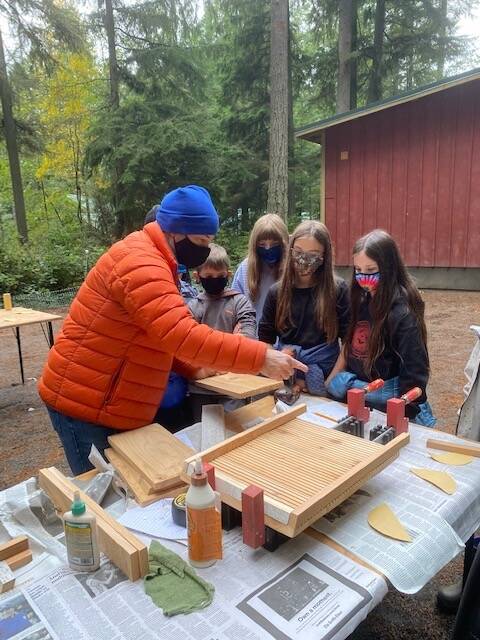Fourth graders at the Whidbey Island Waldorf School built wood homes for local bat populations as part of a series of ongoing conservation projects.
The habitat construction combined lessons in a variety of subjects, letting students use math, science and art skills while teaching them that the nocturnal critters most popularly associated with Halloween spookiness and blood-sucking monsters aren’t so scary after all.
Fourth grade teacher Abigail Hundley said the idea for the habitat project was born when Whidbey’s resident bat expert Sarah Schmidt visited the school.
“The students were inspired by a visit from Sarah during our animal unit. They are concerned about bats being endangered,” Hundley said. “The kids used what they knew about bats in our area to determine what they thought they would need and then did research on the houses themselves to help with the design project.”
There are 10 species of bats in Island County, according to Schmidt, but residents aren’t always aware of them because they only come out at night.
For the same reason, it’s difficult to keep track of the local bat population, but Schmidt said trends in other species provide clues as to how the bats might be faring.
“Some of the bird declines seem to be affiliated or associated with loss of insects that the birds need to feed their babies,” she said. “And of course, our bats are dependent on insects.”
Pesticides and the introduction of non-native plant species are two factors which contribute to the decline of insect populations, Schmidt said. Beyond loss of food sources, bats are also dealing with habitat loss as people tend to clear away the dead or dying trees where bats like to roost.
“That’s one reason why sometimes bats will occupy a bat house,” Schmidt says.
When it comes to real estate, bats are picky shoppers. Bat houses have to meet several specific criteria to be suitable for the furry critters.
The 2-foot-tall houses are open at the bottom, so bats can fly up into them from underneath. Inside, they are lined with vertical crevices large enough for bats, but small enough to keep out predators. At the top is a platform where bats can land in their preferred upside-down fashion.
The top of the box must also be sealed airtight, to trap warm air inside where the bat pups live until they’re big enough to go out and forage on their own. The houses thrive when they’re placed in full sunshine and at least 12 feet above the ground.
The Waldorf fourth graders have taken the initiative to build the houses themselves, with teacher and parental assistance. The skills they’re learning in their math classes have proven useful during the construction.
“Kids are learning about measurement and angles along with getting some building skills which we will use as we go along,” Hundley said.
Joy Broughton, a Waldorf teacher and parent coordinator who has assisted with the project along with her husband, said the kids have enjoyed the bat habitat project, as it has demonstrated the practical application of their learning and given them the chance to make a meaningful difference.
Broughton credited the students with spearheading the research and design process of the project. She said her favorite part of participating in the project has been “seeing them so engaged in what they were doing, and watching them get a chance to put their learning and their creativity into a project that was so important to them, that they really grew all on their own.”
Broughton said the fourth graders developed a “soft spot” for the animals as they learned more about them and created homes for them.
“They’re important to our environment. They’re around us. They’re not something that we need to be afraid of,” Schmidt said.
Constructing bat habitats isn’t the only conservation project the class intends to take on this school year; in the spring, the students plan to build birdhouses and install a native plant garden on the school grounds, funded by a $200 grant from the local Audubon Society.


